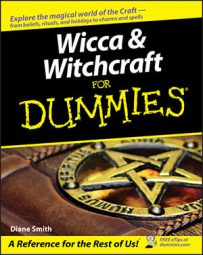Basic design steps for Wiccan ritual
For Wiccans, ritual is a ceremony performed for a specific purpose such as feeling a connection to Deity, and the essence of Wicca. During ritual, Wiccans honor or worship the divine, many work magic, and participants search their hearts and spirits letting the ritual evolve naturally.
The following list shows the basic steps for a practicing a Wiccan ritual:
-
Decide why you want to conduct a ritual. Make sure that your intention is clear.
-
Decide how you want to perform your ritual; write the words that you want to use during the invocation and the other steps.
-
Decide when to do the ritual; for example, you may want to time your ritual to a specific phase of the Moon or to a Wiccan holiday.
-
Decide where to do the ritual, set up an altar, and assemble the tools and other necessary objects.
-
Purify the space.
-
Purify yourself.
-
Cast a circle to create sacred space.
-
Invoke, evoke, or welcome Deity, according to your beliefs.
-
Conduct a ritual observance (for example, celebrate a Sabbat or an Esbat), if you desire.
-
Raise power and work magic, if you have a good reason.
-
Earth the power.
-
Thank (or dismiss) Deity.
-
Take down the circle.
Celebrating the moon on the esbats
The esbats, or Wiccan lunar holy days, celebrate the moon’s passage around the Earth.
The esbats offer Wiccans a chance to regularly put aside time to step away from the ordinary world and dedicate time to spiritual reflection or magical work. The approach to the holy days isn’t all-inclusive. For each phase of the moon, some groups have particular rituals, and the esbats can be celebrated by individuals or covens.
Some Wiccans celebrate an esbat on the:
-
Full moon
-
New moon
-
Full moon and new moon
-
Full moon, new moon, and the quarter moons
Some Wiccans use the word esbat to describe any Wiccan gathering (especially if ritual or magical work takes place) that doesn’t occur on a sabbat.
Celebrating the sun on the sabbats
Wiccan holidays, or sabbats, are timed to the seasons and the Earth’s natural rhythms. Sabbats celebrate the Earth’s journey around the sun, called the Wheel of the Year, and Wiccans refer to commemorating the sabbats as Turning the Wheel.
Most Wiccans celebrate these eight sabbats annually:
-
Yule, Winter Solstice: December 20, 21, 22, or 23
Yule is the longest night and the shortest day of the year. Some Wiccans consider Yule to be either the year’s beginning or the end. This is the time to celebrate the return of the light. Yule is the solar turning of the tides, and the newborn sun offers a fresh start and, literally, a new day. It’s a time of renewal and hope.
-
Brigid, Imbolc, Candlemas, Imbolg, or Brigid’s Day: February 1 or 2
Brigid, or Imbolc, is a preparation for spring. At Brigid, Wiccans clean and organize their living environments, as well as their minds and hearts, in preparation for the upcoming season of growth. It’s a time to shake off the doldrums of late winter and light the fires of creativity and inspiration.
-
Eostar, Spring Equinox, Ostara, or Oestarra: March 20, 21, 22, or 23
Winter is now over. Light is increasing. The day and night are equal in length at the equinox. Spring has arrived or is coming soon. Eostar is the time of fertility, birth, and renewal. The ice is thawing, and the growing season for plants and animals begins. Growth is the theme of the day.
-
Beltane, May Eve, Beltaine, Bealtaine, or May Day: April 30 or May 1
Beltane is the time of the marriage and union of the Goddess as Mother Earth and the God of the Greenwood. It is an ancient fertility festival marking the beginning of the planting cycle. The festival was to ensure a good growing season and a bountiful harvest. Beltane is light-hearted and joyful.
-
Litha, Summer Solstice, or Midsummer: June 20, 21, 22, or 23
Litha is the longest day and the shortest night of the year. Light triumphs, but will now begin to fade into darkness as autumn approaches. The crops are planted and growing. The woods and forests have reached their peak fullness. This is the time of abundance for wildlife, including people! The holiday is joyous.
-
Lughnasad, Lughnasadh, or Lammas: August 1
For the ancient Pagans, Lughnasad was a time of both hope and fear. They held hope for a bountiful harvest and abundant food, but they feared that the harvest wouldn’t be large enough and that the cold months would be filled with struggle and deprivation. At Lughnasad, modern Wiccans also face their fears, concentrate on developing their own abilities, and take steps to protect themselves and their homes.
-
Mabon, Fall Equinox, or Harvest Home: September 20, 21, 22, or 23
At Mabon, the day and the night are equal in length, in sublime balance. For many locations, Mabon coincides with the final harvest of grain, fruits, and vegetables. Mabon, also called Harvest Home, is the time of thanksgiving. The beauty and bounty of summer gives way to the desolation of winter, and the darkness overtakes the light.
-
Samhain, All Hallow’s Eve, Hallowmas: October 31 or November 1
For many Wiccans, Samhain marks the New Year and is the most important Sabbat. It’s the time to remember the ancestors, and the time to celebrate the harvest and all that has been accomplished over the year.

